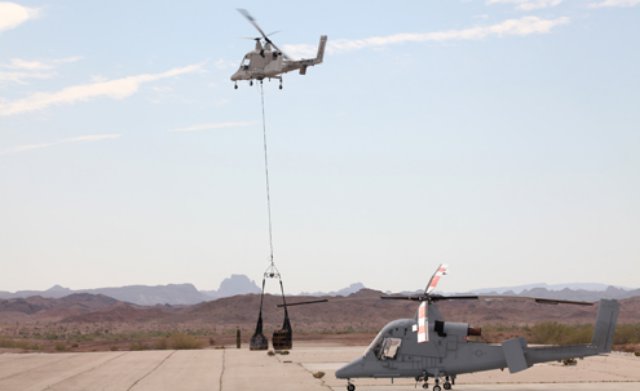 While US Marines have heaped praise on the K-MAX unmanned cargo system, its future as a potential programme of record remains uncertain.
While US Marines have heaped praise on the K-MAX unmanned cargo system, its future as a potential programme of record remains uncertain.
Fielded after an urgent request from the military, the Lockheed Martin/Kaman Aerospace Corp. helicopter has been in Afghanistan for 18 months and heralded as a lifesaver.
“The performance from this aircraft has been absolutely superb,” said Marine Major Daniel E. Lindblom, operations officer for the Marine Unmanned Aerial Vehicle Squadron 3.
Lindblom lauded the aircraft’s speed and high-altitude performance, as he spoke from Afghanistan May 1 during a teleconference with reporters.
The K-MAX, which has dual intermeshing rotors, can be used autonomously to rapidly transport a myriad of items, including food, water, medical supplies and ammunition in emergency situations.
To date, the K-MAX has delivered more than 3.2 million pounds of cargo, officials said. Brought to Afghanistan in November of 2011, the Marine Corps recently announced the indefinite extension of the K-MAX mission.
For now, what will happen to the K-MAX after Afghanistan remains uncertain, said Navy Captain Patrick Smith, Programme Manager at Navy and Marine Corps Multi-Mission Tactical Unmanned Air Systems programme office.
“We are working with headquarters Marine Corps on options going forward [but] … there is still no definitive date or decision that has been made to the system coming back to the United States,” said Smith, speaking from Naval Air Systems Command in Patuxent River, Md.
One option may be sending the UAS to the Yuma Proving Grounds in Arizona for demonstrations and testing, Smith said.
“Right now, we do not have any formal requirements from the Marines to go forward beyond the demos we’ve got here, but there’s definitely been lessons learned going forward from the 18 months we’ve been there,” Smith said.
The K-MAX was fielded to safely and quickly transport emergency cargo in dangerous areas. After an uncommonly swift introduction, two helicopters were purchased at a cost of $11 million each to deliver cargo from main supply depots to isolated forward operating bases.
The K-MAX is the only unmanned cargo system on the Marine’s radar, said Smith.
Another similar programme, the Autonomous Aerial Cargo/Utility System, is currently in development at the Office of Naval Research.
“Right now, the K-MAX … is our focus as far as cargo goes. The Marine Corps has not asked us to go back and review other options,” said Smith.
Lindblom said that he would like it to carry a heavier payload. A camera to face the load would also be a welcomed upgrade, as the GPS-operated vehicle currently has no visual capabilities, he said.
The Marine Corps wanted a UAS that could carry 750 pounds per trip and at least 6,000 pounds of cargo a day, Smith said. So far, there is a record of 30,000 pounds carried in one day by a K-MAX, said Roger Il Grande, Director of Airborne Systems at Lockheed Martin Mission Systems & Sensors.
In January, the K-MAX delivered emergency ammunition to an undisclosed location in Afghanistan that was under attack by insurgents. Deemed too risky for manned helicopters to fly, the K-MAX was able to travel 25 miles and resupply the troops with ammunition, Lindblom said.
While the K-MAX does not replace manned cargo transportation, it reduces the number of Marines and convoys that have to travel, and subsequently keeps some troops out of harm’s way from things like improvised explosive devices, Lindblom said.
“Because of the fact that we only have the two aircraft out here, it’s not completely eliminating the need for manned aircraft, it’s not completely eliminating the need for convoys. However… it is making a dent in the size of the convoys, little by little, and it’s reducing the [number of] aircraft that have to be flown to these zones,” said Lindblom.
Photo Credit: Lockheed Martin
Source: National Defense Magazine
